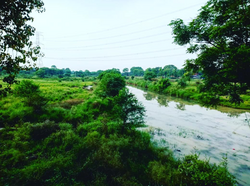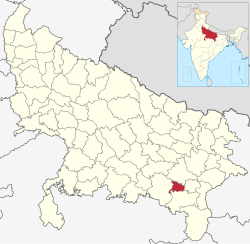
Mirzapur is a city in Uttar Pradesh, India, 827 km from Delhi and 733 km from Kolkata, almost 91 km from Prayagraj and 61 km from Varanasi. It is known for its carpets and brassware industries, and the tradition of kajari and birha music. The city is surrounded by several hills of the Maikal range and is the headquarters of Mirzapur district.

Jaunpur is a city and a municipal board in Jaunpur district in the Indian state of Uttar Pradesh. It is located 228 km southeast of state capital Lucknow. Demographically, Jaunpur resembles the rest of the Purvanchal area in which it is located.

Varanasi division is one of the 18 administrative geographical units of the northern Indian state of Uttar Pradesh. Varanasi city is the administrative headquarters of the division. The division consists of 4 districts, i.e. Varanasi, Chandauli, Ghazipur, and Jaunpur and is loosely equivalent to the Benares State.

Mirzapur division, also sometimes known as Vindhyachal division, is one of the 18 administrative geographical units of the northern Indian state of Uttar Pradesh. Mirzapur city is the administrative headquarters. Currently, the division consists of 3 districts:-

Mirzapur district is one of the 75 districts in the Indian state of Uttar Pradesh. The district is bounded on the north by Bhadohi and Varanasi districts, on the east by Chandauli district, on the south by Sonbhadra district and on the northwest by Prayagraj. The district occupies an area of 4521 km2. Mirzapur city is the district headquarters. Mirzapur district is a part of Mirzapur division. This district is known for the Vindhyavasini temple in Vindhyachal and several tourist attractions like water falls like Rajdari & Devdari and dams. It consist of several Ghats where historical sculptures are still present. During the Ganges festival these Ghats are decorated with lights and diyas.
Bhadohi is a city and municipal corporation in the northern Indian state of Uttar Pradesh. As the district headquarters of Bhadohi, it is home to the largest hand-knotted Carpet weaving industry hub in South Asia. The city is known for its long-standing tradition of carpet weaving that results in high-quality craftsmanship, durability, and unique patterns. Bhadohi has huge geographical significance and position attached to it due to its location between two culturally important and rich heritage cities of Prayagraj and Varanasi.
Ghosia Bazar is a town and a nagar panchayat in Bhadohi district in the Indian state of Uttar Pradesh. It is also known as Indian Carpets Hub. Ghosia is the most developed place in Sant Ravidas Nagar, where the huge amount of Carpets are manufactured and exported abroad. Major population of Ghosia is engaged in Carpets business.
Gopiganj is a town and a municipal board in Bhadohi district in the Indian state of Uttar Pradesh. It is located beside the river Ganges, almost equidistant from Prayagraj and Varanasi on National Highway 2.

Janghai is a market and Gram Panchayat in the district of Prayagraj, in the Indian state of Uttar Pradesh. It is located 226 km kilometres southeast of the state capital, Lucknow, and 24 kilometres from Handia Tehsil. As of 2022, Janghai's population was about 29,000.

The Culture of Uttar Pradesh is an Indian culture which has its roots in Hindi, Bhojpuri and Urdu literature, music, fine arts, drama and cinema. Lucknow, the capital of Uttar Pradesh, has historical monuments including Bara Imambara and Chhota Imambara, and has preserved the damaged complex of the Oudh-period British Resident's quarters, which are being restored.

Situated in the northern part of India, bordering with the capital of India New Delhi, Uttar Pradesh is one of the most popular and an established tourist destination for both Indians and non-Indians alike in India. The most populous state of India, Uttar Pradesh contains many historical monuments and places of religious significance. Geographically, Uttar Pradesh is very diverse, with Himalayan foothills in the extreme north and the Gangetic Plain in the centre. It is also home of India's most visited sites, Hinduism's holiest city, Varanasi. Kumbh city, Prayagraj. Kathak, one of the eight forms of Indian classical dances, originated from Uttar Pradesh. Uttar Pradesh is at the heart of India, hence it is also known as The Heartland of India. Cuisine of Uttar Pradesh like Awadhi cuisine, Mughlai cuisine and Bhojpuri cuisine are very famous not only in India but also many places abroad.
The demographics of Uttar Pradesh is a complex topic, which is undergoing dynamic change. Uttar Pradesh is India's most populous state, and the largest subdivision in the world. It has a population of about 199,812,341 as per the 2011 census. If it were a separate country, Uttar Pradesh would be the world's fifth most populous nation, next only to China, the rest of India, the United States of America and Indonesia. Uttar Pradesh has a population more than that of Pakistan. There is an average population density of 828 persons per km2 i.e. 2,146 per sq mi. The capital of Uttar Pradesh is Lucknow, and Prayagraj serves as the state’s judicial capital. Hindus and Muslims both consider the state as a holy place.
Bhadohi Lok Sabha constituency is one of the 80 Lok Sabha (parliamentary) constituencies in Uttar Pradesh state in northern India. This constituency came into existence in 2008 as a part of the implementation of delimitation of parliamentary constituencies based on the recommendations of the Delimitation Commission of India constituted in 2002.
Ramaipur is a village in Bhadohi district, Uttar Pradesh, state India. The village is located on the link road which connects Chauri Bazar at Varanasi-Bhadohi road to Maharazganj Bazar on Varanasi-Allahabad road. The nearest railway station is Parasipur railway station on the line connecting Lucknow to Varanasi via Bhadohi. The Parasipur railway station is 7 kilometres from the village. The village market is spread adjacent to the pitch road. The bazaar has at least 10 grocery shops, three primary schools, four barber shops at least half a dozen sweet shops and dozen chai and pan shops. The weekly sabzi bazar is conducted on Thursday. The market provides daily use items to nearby villages too. there are more than twenty self-appointed medical practitioners, none qualified academically. However, these jhola chap doctors offer primary health services to many people around Ramaipur.the most famous person in this village is Pt Samar Nath Mishra. He is about 85 years now.
Anegpur is a village of Bhadohi district in the state of Uttar Pradesh in northern India. It comes under Bhadohi Lok Sabha constituency. Anegpur is a carpet manufacturing village in Bhadohi. It is known for its hand-knotted carpet and Indo Gabbeh.
Sitamarhi Bankat is a Hindu village situated in Sant Ravidas Nagar Bhadohi District Uttar Pradesh, India.This village is located on the banks of Ganga river and 11 km from Jangiganj Bazar in the middle of prayagraj and Varanasi.
Meerganj is a village in Jaunpur district in the Indian state of Uttar Pradesh. Meerganj is located 6 km kilometres north-east of Janghai Junction railway station and 1 km west of Jarauna railway station.

Sant Ravidas Ghat is the southernmost and largest ghat in Varanasi. To most visitors to Varanasi, it is known for being an important religious place for Ravidasis with a 25 acres park known as Sant Ravidas Smarak Park.
Poore Bahuriya or PooreBahuria is a village in Bhadohi district in the Indian state of Uttar Pradesh under Gopiganj police station. Purebahuriya is located in Gyanpur Taluk. The population of the village was recorded as 1239 in the 2015 census.













